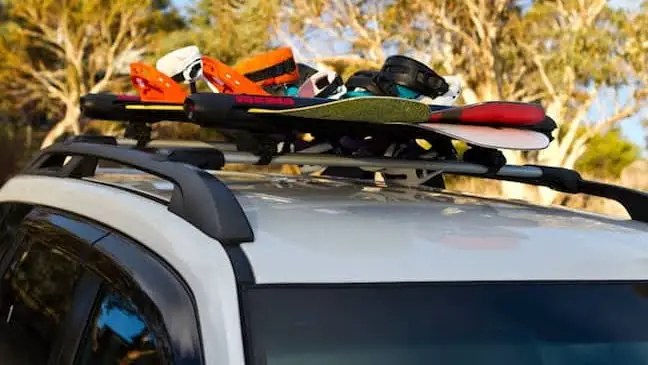You’ve come to the right place if you’re in the market for the best hiking packs. Our team of adventure specialists has put 20 different backpacks to the test on routes throughout the world for 2022.
No matter how much or how little hiking experience you have, you understand the need for having the proper equipment. It might be the deciding factor between a memorable outdoor experience and a disappointing one. The best hiking packs are one of the most crucial pieces of gear for any outdoor adventure.
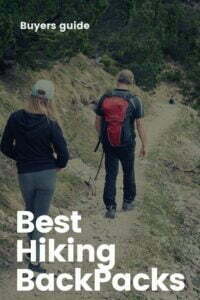 You may certainly grab any old bag and fill it to the brim with hiking gear before setting out on the trails. However, whether you’re going on a day trip or a weeklong trek, hiking backpacks provide superior convenience and support.
You may certainly grab any old bag and fill it to the brim with hiking gear before setting out on the trails. However, whether you’re going on a day trip or a weeklong trek, hiking backpacks provide superior convenience and support.
There are a lot of variables to think about while picking the proper backpack, such as size, shape, material, weight, comfort, endurance, and suspension. For this reason, I am here to assist you in reducing the number of options to those that are truly worthy of your consideration.
For that reason, let’s not waste any more time and get right into my recommendations for the best hiking packs of 2022.
Table of Contents
ToggleBest Hiking Packs Comparison Table
Osprey Atmos AG 65
Our ratings
- Anti-Gravity suspension makes your pack feel lighter.
- Fit-on-the Perfect-fitting Fly hipbelt.
- 30-50 lbs. - Medium pack, 34.25 x 15.35 x 16.14 in., weighs 4.56 lbs.
Osprey Rook 65 Backpack
Our ratings
- 2 zippered hipbelt pockets, 2 dual access stretch mesh side water bottle pockets
- 600 denier polyester (main), 450 denier polyester, 1000 denier nylon packcloth
- Volume: 65 L
- Weight: 3.52 lbs.
Osprey Ariel 65
Our ratings
- 420HD Nylon Pack Cloth, 210D Nylon Diamond, PFC-Free DWR Coating
- 65 Liters
- 31.5” x 15.75” x 11.02”
- 4.93 lbs.
- Included rainfly
Osprey Talon 22 / Tempest 20
Our ratings
- Perfect-fitting shoulder harness.
- Side mesh pockets hold bottles and smaller stuff.
- Hipbelt pockets and LidLock helmet attachment.
- Volume: 22 Liters
- Dimensions: 22.05 x 9.84 x 9.06 inches.
Osprey Aether 65 Men's Hiking Pack
Our ratings
- 420HD Nylon Pack Cloth, 210D Nylon Diamond, PFC-Free DWR Coating
- 65 Liters
- 31.5” x 15.75” x 11.02”
- 4.93 lbs.
- Included rainfly
Gregory Zulu 55
Our ratings
- Volume 55 Liters
- Dimensions 28” x 13.25” x 12”
- Weigh 3.3 lbs.
- Empire Blue, Mantis Green
Jack Wolfskin Highland Trail 55
Our ratings
- 280D Cross Rip Polyamide and 300D Cross Rip Polyester, Polyester Lining, DWR Coating, YKK Zippers
- 55 Liters + Expandable 5 Liters
- 14.96” x 12.6” x 32.28”
Gregory Paragon 58
Our ratings
- Nylon Body (100D, 210D), 420D Nylon Base, 135D Recycled Polyester Lining, LifeSpan EVA Foam, Aluminum Frame.
- 58 Liters
- 23.62” x 14.17” x 9.06”
- Volume 3.47 lbs.
TETON Sports Scout 3400 Backpack
Our ratings
- 600D Diamond Ripstop Nylon, 600D Polyester Oxford Canvas
- 55 Liters + Expandable 5 Liters
- 30” x 17” x 12”
- Weight: 4.5 lbs.
- Black, Burnt Orange, Huckleberry, Mecca Orange, Olive, Tan
Arc’teryx Bora AR 63
Our ratings
- 420- and 630-Denier Rip-stop Nylon
- Frame: Internal
- 6 + external compartment
- 30 x 24 x 13 inches
- 5 lbs. 0.1 oz. (Regular)
Mystery Ranch Glacier
Our ratings
- 550-denier Lite Plus Cordura Nylon
- Internal Composite
- 4 + main compartment
- 34.5 x 13.5 x 13.5 inches
- Weight: 6 lbs. 6.4 oz
Hyperlite Mountain Gear 2400 Southwest 40L
Our ratings
- Material: Dyneema
- Frame: Internal
- 3 exterior pockets, 2 zippered waist belt
- 26 x 17 x 5 inches
- 1 lb 14 oz. (White)
Granite Gear Blaze 60L
Our ratings
- 100-denier ROBIC high-tenacity nylon with Barrier DWR, 210-denier ROBIC UHMWPE triple ripstop nylon
- Adjustable Air Current
- 3 + external compartment
- 23.5 x 13 x 8 inches
- 3 lbs. (Regular)
Osprey Xena 85
Our ratings
- 420-denier/210-denier high-tenacity nylon/500-denier nylon packcloth
- Internal lightwire
- 9 + main compartment
- 33 x 17 x 15 inches
- 5 lbs. 5 oz. (Medium)
The North Face Terra 65
Our ratings
- Material: 600-denier Polyester
- Internal Aluminum
- 9 + main compartment (Small/Medium
- 20 x 14 x 4 inches
- 4 lbs. 5.8 oz
The North Face Terra 65aLowe Alpine AirZone
Our ratings
- 210D mini-ripstop nylon, 450D polyester
- Frame: Internal
- Contain 6 Pockets
- 26 x 14.2 x 11.8 inches
- 3 lbs. 92 oz.
Osprey Levity 60 Ultralight
Our ratings
- 30-denier ripstop Cordura silnylon/NanoFly 210-denier nylon x 200-denier UHMWPE
- Internal Aluminum
- 4 + main compartment
- 28 x 16 x 13 inches (Medium)
- 1 lb. 15.2 oz (Medium)
Berghaus Ridgeway 65+10L
Our ratings
- 600-denier Polyester
- Frame: Internal
- 31 x 15 x 12.6 inches
- Weigh 4 lbs.
Kelty Coyote 65
Our ratings
- Poly 420D Small Back Stafford.
- Internal Spring Steel + HDPE.
- 5 + main compartment.
- 30 x 18 x 12 inches.
- 4 lbs. 10 oz.
Sierra Designs Flex Capacitor
Our ratings
- 100D Nylon-Poly Ripstop, 420D Nylon Oxford.
- Aluminium Y-Flex internal DAC frame.
- 2 + main compartment.
- Size is 27.5 x 11.5 x 10 inches.
- Weigh is 2 p. 9.2 oz.
Best Hiking Packs: Review
1. Osprey Atmos AG 65
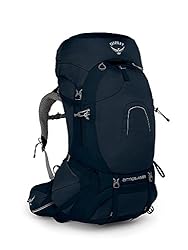 When it comes to backpacks, we recommend the Atmos AG (and the Aura AG for women) because of the excellent balance it strikes between comfort, efficiency, and durability. The “Anti-Gravity” suspended mesh backpanel is a show-stopper since it eliminates the bulky foam of conventional designs while improving airflow and comfort. But the Atmos has other advantages as well: The new Fit-on-the-Fly collar and hip belt provide an easily changeable fit, the quality materials are durable, and the pocket design is well-organized with lots of space for separating out stuff. When it comes to backpacks, the Atmos is one of the most versatile options available, suitable for everything from day hikes to multi-day excursions.
When it comes to backpacks, we recommend the Atmos AG (and the Aura AG for women) because of the excellent balance it strikes between comfort, efficiency, and durability. The “Anti-Gravity” suspended mesh backpanel is a show-stopper since it eliminates the bulky foam of conventional designs while improving airflow and comfort. But the Atmos has other advantages as well: The new Fit-on-the-Fly collar and hip belt provide an easily changeable fit, the quality materials are durable, and the pocket design is well-organized with lots of space for separating out stuff. When it comes to backpacks, the Atmos is one of the most versatile options available, suitable for everything from day hikes to multi-day excursions.
Recent iterations of the Atmos have been updated with features including a torso length regulator, an integrated raincover, and dual side zippers for easy access to the main area. To further reduce their environmental impact, Osprey updated the pack’s materials to use a PFC-free permanent water – resistant coating, as have many other outdoor equipment manufacturers. The Atmos AG 65 followed suit, seeing a price increase (up $30 with the latest update) that unexpectedly makes it more expensive than the upgraded Aether below it. However, the Atmos AG 65 offers the best overall mix of weight, carrying ease, and functionality for any length of backpacking trip from a single night to a full week. The Osprey Aether 65 Men’s Hiking Pack among the finest hiking packs for beginners.
What we like
- Divided into several compartments
- Lightweight.
- Brings a lot of ease to one's life.
- Consists of superior raw materials and construction.
- It fits really closely.
- Countless storage compartments on the outside
What we don't like
- Hip belt edges that aren't fully cushioned might be irritating.
- Cannot handle loads of more than 45 pounds.
- Possibility of developing a squeaky sound.
2. Osprey Rook 65 Backpack
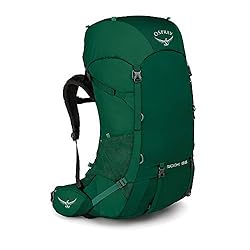 The Osprey Rook 65 is a fantastic option if you’re looking for high-quality hiking packs that won’t break the budget. It’s ideal for day trips or short multi-day excursions because of its ability to carry small to medium loads. The wireframe design allows for a portion of the weight, up to 40 pounds, to be transferred to the hip belt.
The Osprey Rook 65 is a fantastic option if you’re looking for high-quality hiking packs that won’t break the budget. It’s ideal for day trips or short multi-day excursions because of its ability to carry small to medium loads. The wireframe design allows for a portion of the weight, up to 40 pounds, to be transferred to the hip belt.
This lightweight hiking bag has only the bare minimum of features and storage space to justify its low price. While trekking, you’ll have quick access to the items in the top lid pocket, the mesh water bottle pockets, and the bottom compartment. An inside hydration sleeve can hold up to 3 liters of liquid, and there is a separate space for your sleeping bag to keep it safe.
To beat the heat, the Rook 65, like the Atmos and Aura, features an excellent ventilation system. The FlapJacket on this bag is not only watertight but also useful for separating your dry belongings from the wet ones and keeping them apart.
You won’t find a better deal than this bag.
What we like
- A rainy day is no problem with the FlapJacket.
- Durable.
- Guaranteed for the rest of your life.
- There are more than five external pockets.
What we don't like
- Thin padding on the shoulder straps and hip belt raises concerns about comfort.
- Access to the top lid is limited.
3. Osprey Ariel 65
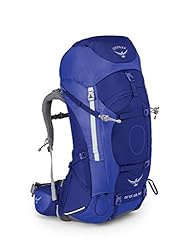 This is the ideal hiking bag to take with you on your travels if you routinely engage in multi-day excursions. There’s a women’s version, the Ariel 65, and a men’s version, the Aether 65. Even though it’s one of the heaviest backpacks around, you can rest assured knowing that your weight will be safely transported. It has several features and customization options, much like almost every other Osprey pack.
This is the ideal hiking bag to take with you on your travels if you routinely engage in multi-day excursions. There’s a women’s version, the Ariel 65, and a men’s version, the Aether 65. Even though it’s one of the heaviest backpacks around, you can rest assured knowing that your weight will be safely transported. It has several features and customization options, much like almost every other Osprey pack.
The LightWire frame with breathable back panels provides excellent suspension to make even the heaviest weights comfortable to carry. Even on the longest hikes, you’ll be as comfortable as possible thanks to the on-the-fly shoulder pad expansion, hip belt, and torso length adjustment. Without straining yourself too much, you can lug about up to 60 pounds of stuff in a 55-liter pack.
Shove your things into the main compartment and quickly reach it later through the zipped front panel or top cover. You can keep your sleeping bag neat and tidy while also carrying your other gear in the hip belt compartments. Both of your water bottles may be stored safely in the two separate water bottle compartments.
Adjustable shoulder straps, torso and hip belt allow for a personalized fit regardless of your build. It’s one of the finest backpacks for hiking since you can change the size of the straps to match the weight you’re carrying without putting too much stress on your back.
Check out my review of the Osprey Aether to learn more about why I think it’s among the best hiking packs.
What we like
- Extremely malleable.
- Capable of carrying weights with ease.
- Full of useful options.
- Comfortable.
- Provides protection against the rain.
What we don't like
- The weight might be an issue.
- Water bottle return is not as simple as water bottle removal.
4. Osprey Talon 22/Tempest 20
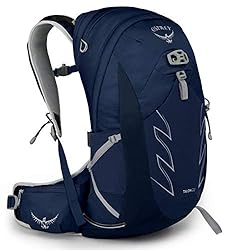 If you’re looking for a lightweight and small daypack, look no further than the Osprey Talon 22 or the Tempest 20 for the ladies. The recycled 100D and 420D nylon fabric used to construct the pack makes it durable and also resistant to water. The padded shoulder straps and ventilated back panel provide the pack with good suspension and keep you from sweating too much.
If you’re looking for a lightweight and small daypack, look no further than the Osprey Talon 22 or the Tempest 20 for the ladies. The recycled 100D and 420D nylon fabric used to construct the pack makes it durable and also resistant to water. The padded shoulder straps and ventilated back panel provide the pack with good suspension and keep you from sweating too much.
Despite its small size, this is the best daypack I’ve discovered due to its numerous convenient features. It can carry up to 30 pounds in weight and has a capacity of 22 liters (20 liters for the Tempest).
The hip belt and top compartments are each zippered for easy access to your phone, sunscreen, and other necessities. Staying hydrated while hiking is easy thanks to this pack’s ability to carry a 3-liter water sleeve and two water bottles in their separate side pockets.
A secure and comfortable fit is ensured by the waist belt and shoulder straps, which can be adjusted to suit the wearer’s needs; a whistle is also provided in case an aid is needed. The backpacks may be modified to accommodate a variety of equipment, including a helmet, ice axle, and trekking poles.
What we like
- Lightweight.
- Extremely malleable.
- Superb air circulation.
What we don't like
- The side pockets could be too tight.
- Sometimes zippers get stuck.
5. Osprey Aether 65 Mens Hiking Pack
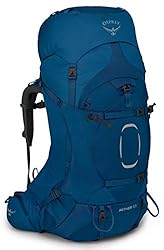 As the preferred option for many nature enthusiasts who want to spend their days outside, Osprey is a popular brand of outdoor gear. They offer a variety of backpacks to select from, so you can take your pick regardless of whether you’re intending to bike across the nation or embark on a hiking trail excursion across the seas. The Aether AG 60 is a hiking pack made for long-distance walks and alpine adventures that demand a lot of gear and lots of supplies for all participants.
As the preferred option for many nature enthusiasts who want to spend their days outside, Osprey is a popular brand of outdoor gear. They offer a variety of backpacks to select from, so you can take your pick regardless of whether you’re intending to bike across the nation or embark on a hiking trail excursion across the seas. The Aether AG 60 is a hiking pack made for long-distance walks and alpine adventures that demand a lot of gear and lots of supplies for all participants.
The Aether backpack is designed with heat-moldable zipped hip-belt compartments and side compression straps to evenly distribute your load. The backpack has an anti-gravity suspension and back panel to protect the wearer from experiencing any discomfort in that area.
The sleeping bag compartment and integrated hydration reservoir sleeve give the utmost in luxury and convenience. The top cover of this hiking bag may be removed to reveal a daypack within.
What we like
- Customizable harness ensures comfortable carrying.
- White marks guide fit adjustments.
- Super-breathable back frame.
- Lots of pockets.
- Many bungees and clips for accessories.
What we don't like
- While wearing, hip belt pockets are difficult to open or close.
- Front carrying handles would be handy.
- Expensive hiking backpacks.
6. Gregory Zulu 55
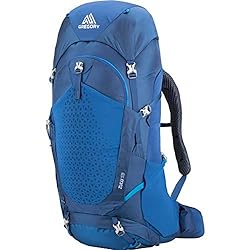 Having high-quality the best hiking packs are crucial for having a good time on the trail, and recently Gregory has been making some great alternatives available. Backpacking enthusiasts will appreciate the Gregory Zulu, a 55-liter pack designed for use in the great outdoors.
Having high-quality the best hiking packs are crucial for having a good time on the trail, and recently Gregory has been making some great alternatives available. Backpacking enthusiasts will appreciate the Gregory Zulu, a 55-liter pack designed for use in the great outdoors.
It has everything you need to stay organized and safe in the wilderness.
However, a hiking backpack is similar to other types of gear, such as shoes or automobiles. In this regard, they all feature distinctive aesthetics that might either mesh with your own taste or rub you the wrong way.
We put the Gregory Zulu 55 Backpack through its paces so you can make an informed decision as to which of these options is best for your journey. Gregory Zulu 55, are the best hiking packs for the active hiker.
What we like
- FreeFloat suspension is breathable and comfortable.
- Even wide shoulders fit.
- Water bottle holders with compression straps for any bottle size.
- The sternum strap has a whistle and tube clip.
- Front-loading U-Zip makes the main compartment easy to reach.
What we don't like
- Hard-to-open hip belt pockets.
- Extra front (top and bottom) haul loops let you transfer the bag when the front is open.
7. Jack Wolfskin Highland Trail 55
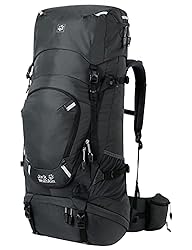
Do you want trendy, low-cost hiking packs you can use in the city and on short trips out of town? In such cases, perhaps the Jack Wolf Skin Highland Trail 55 Backpack is the best backpack for you.
The Jack Wolfskin brand is well-known for pioneering new types of crossover items. The German firm’s outdoor and city gear is of high enough quality and reasonable enough cost to be taken seriously.
They say they will provide you with a nylon backpack suitable for both urban exploration and trips into the woods.
A subset of weekend warriors have found the combined functionality and convenience of these products to be highly appealing in recent years.
We tested this Jack Wolfskin bag to see if it lived up to our high expectations.
What we like
- Style works indoors and out.
- Best clamshell opening.
- A zipped front pocket secures everything you need within reach.
- Sleeping bag space.
- You may add 5 liters on top.
What we don't like
- Back padding isn't breathable.
- Missing crisscross bungee cords or a wet-item mesh pocket.
8. Gregory Paragon 58
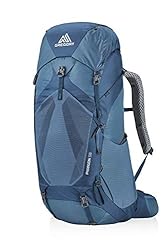 One might argue that Gregory is the go-to label for those who take their outdoor pursuits seriously. Both their technological features and their price tags tend to be greater. However, this is precisely why seasoned campers and hikers choose higher-quality equipment.
One might argue that Gregory is the go-to label for those who take their outdoor pursuits seriously. Both their technological features and their price tags tend to be greater. However, this is precisely why seasoned campers and hikers choose higher-quality equipment.
Gregory’s goal in releasing the Paragon 58 was to prove that its name was not a coincidence. When it comes to carrying heavy loads through tough terrain, this 58-liter pack is tailor-made for the male form.
The Paragon is an improvement on previous hiking backpacks thanks to its innovative suspension system, making the trip and the night spent in a tent in the woods more pleasant. The cleverness of the bag’s layout, such as its ability to be loaded from the side, is undeniable.
The weatherproofness and longevity of this bag have been thoroughly examined. We did so with great hopes that the Paragon would conform to the shape of our backs as we climbed, stomped, and wriggled through a wide variety of terrains. See how well it performed in our evaluation.
What we like
- Sideloading provides rapid main compartment access.
- Extra gear lash points.
- Lightweight.
- Back ventilation.
- 2-way bottle holder for easy drinking.
What we don't like
- Hard-to-open hip pockets.
- Load lifter adjustment is difficult.
- Left water bottle holster needs side access.
- Low tear-resistance.
9. TETON Sports Scout 3400 Backpack
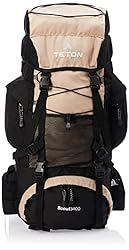 Looking for an excellent hiking bag but don’t want to spend a fortune? Do you wish to experience the joys of backpacking without breaking the bank? You might benefit from the features of the TETON Sports Scout 3400 Backpack.
Looking for an excellent hiking bag but don’t want to spend a fortune? Do you wish to experience the joys of backpacking without breaking the bank? You might benefit from the features of the TETON Sports Scout 3400 Backpack.
If you’re looking for a minimalist rucksack with all the essentials of a travel/hiking pack, go no farther than this 55-liter big backpack by TETON.
If you need a backpack but have a limited budget, you may want to choose the TETON Sports Scout 3400. It might also serve as a practical weekend bag or a reliable travel companion on your annual hiking excursion.
Maybe it would be preferable to spend the money on a higher-quality bag.
We have tested the TETON Sports Scout 3400 Backpack and compared it to other, more well-known brands to give you an unbiased assessment of its capabilities and limitations among the best hiking packs. The TETON Sports Scout 3400 Backpack are the best hiking packs for the money.
What we like
- It has a built-in hydration sleeve.
- The frame and harness are comfortable.
- Extra-large side zipped pockets.
- Front bungees hold objects.
- The inbuilt rain cover is time-saving.
What we don't like
- Pocketless hip belts.
- Tall bottles won't fit.
- Cheap zips.
- Small sleeping-bag compartment.
- Non-stretchable mesh front pocket.
10. Arc’teryx Bora AR 63
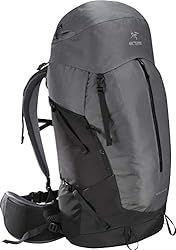 With the best hiking packs, like the Arc’teryx Bora AR 63, which is designed to support your weight, you’ll be as mobile as ever. With features like RotoGlide hip-belts and GridLock shoulder straps, your backpack will never interfere with your ability to maintain equilibrium. The vented back panel helps keep your back feeling cool even after hours of trekking, while the hip belts rotate for a more natural stride and the shoulder straps are adjustable for both height and breadth.
With the best hiking packs, like the Arc’teryx Bora AR 63, which is designed to support your weight, you’ll be as mobile as ever. With features like RotoGlide hip-belts and GridLock shoulder straps, your backpack will never interfere with your ability to maintain equilibrium. The vented back panel helps keep your back feeling cool even after hours of trekking, while the hip belts rotate for a more natural stride and the shoulder straps are adjustable for both height and breadth.
The backpack is constructed from 420 and 630-denier nylon and is equipped with AC fabric that is both water- and snow-resistant. The design of the pack makes it such that it may be loaded from the top. This is typically a drawback; however, this specific model has zippers on both sides, so you can always get to the stuff you stashed in the bottom.
There’s a big outside pocket for when it starts to rain or snow a lot, so you can put your wet stuff there. Every eventuality has been planned for, ensuring your safety and well-being. The Arc’teryx Bora AR 63 is the world’s most comfortable hiking pack.
What we like
- The rotating hip-belt is innovative.
- Tegris and aluminum stays help distribute weight uniformly.
- The backpack's double waterproof fabric never absorbs water.
What we don't like
- High cost.
11. Mystery Ranch Glacier
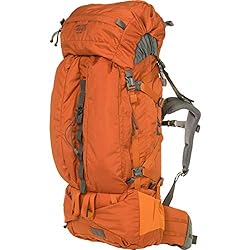 Highest-quality construction The sturdy nylon construction and composite internal frame give the Mystery Ranch Glacier backpack its durability, making it a formidable opponent in the hiking equipment market. Because of its superior construction, this bag will serve you well for many years.
Highest-quality construction The sturdy nylon construction and composite internal frame give the Mystery Ranch Glacier backpack its durability, making it a formidable opponent in the hiking equipment market. Because of its superior construction, this bag will serve you well for many years.
The Glacier contains 2 vertical torpedo compartments and a Speedzip pocket that allows for quick and simple access to your items, including the sleeping bag, so you won’t need any more accessories for the storage of your supplies.
What sets it apart is its movable cover, which allows you to convert it into a daypack with two large pockets. Water bottle storage and trekking pole loops are included for your convenience on hikes.
What we like
- Tough Nylon ensures durability.
- The top-loading design makes packing trekking necessities easy.
- The 71-liter volume lets you pack for a weeklong excursion.
What we don't like
- Heavier than others.
- No belt-hip pockets.
12. Hyperlite Mountain Gear 2400 Southwest 40L
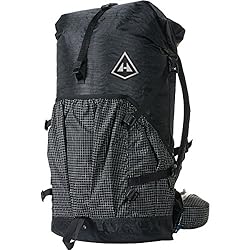
The Hyperlite Mountain Gear 2400 Southwest is aptly dubbed the “minimalist overnighter” among hikers. It’s lightweight and comfortable enough to carry about while canyoneering, traveling difficult paths, or ascending steep mountains. The Dyneema material makes it extremely lightweight while still being strong enough for strenuous backpacking trips. The mesh foam in the waist belt and shoulder straps work together to evenly distribute your weight.
A pair of detachable metal stays allow for flexible load adjustment. Your hiking backpack will likely last a long time since it is made from the same materials that are used to catch climbers who fall.
In order to keep your belongings dry in the case of rain or snow, the Southwest version features taped seams and a roll-top closure. Put your water bottle in the water intake sleeve and load up the pockets on your waist belt; then, you’ll be prepared for your adventure. Among the lightweight, the best hiking packs is the Hyperlite Mountain Gear 2400 Southwest 40L.
What we like
- Dyneema Suspension improves load security and comfort.
- Low-weight hiking packs let you pack more.
- Side and top compression straps can be tightened to stabilize loads.
What we don't like
- The backpack's simplicity may disappoint some.
13. Granite Gear Blaze 60L
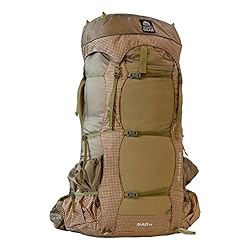
Comfort, quality, and durability all come together perfectly in Granite Gear’s Blaze hiking backpack. The Air Current frame is a modern addition that ensures a tight fit regardless of your torso size. When carrying a heavy pack on a lengthy trip, this is an absolute must.
As a result of the Re-Fit hip-belt and the molded foam back panel, you can safely carry up to 50 pounds of gear into your backpack without worrying about damaging the fabric. Robic Nylon, a high-abrasion fabric, gives the backpack an unprecedented lifetime compared to any other hiking backpack.
You can keep your belongings dry and yet have rapid access thanks to the cinch and roll closing technique. The backpack’s lift may be detached entirely, allowing you to use it as a chest bag to carry your necessities. The Granite Gear Blaze 60L are indeed the toughest best hiking packs out there
What we like
- Dual huge belt-hip pockets can hold many of your items you need immediately.
- The 60 liters are excellent for weekend excursions and weeklong backpacking trips.
- The 3-tier side and front compression strap works wonderfully.
What we don't like
- Insufficient back ventilation.
14. Osprey Xena 85
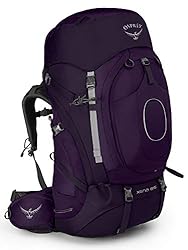 Osprey’s Xena 85-liter is a hiking backpack built to withstand everything the trail ahead may throw at you. An adjustable BioForm torso harness and an AirSpace back panel that provide comfort and ventilation were designed by the manufacturer with extended hours of exploration in the wild in mind.
Osprey’s Xena 85-liter is a hiking backpack built to withstand everything the trail ahead may throw at you. An adjustable BioForm torso harness and an AirSpace back panel that provide comfort and ventilation were designed by the manufacturer with extended hours of exploration in the wild in mind.
This model’s Stow-on-the-Go function is great for rapidly affixing trekking poles to the pack, and it’s not available on any other model. The Bioform CM hip-belt, which can be adjusted to fit you perfectly, helps you spread your load out evenly and has enough of room for your gear. You can get to your belongings quickly and easily without opening the backpack all the way because of the bottom base compartment zips and the dual side-zips.
When you’re on the go and don’t have a moment to spare, these functions come in handy. Make use of the front and side Powermesh pockets to store your water bottle, sunscreen, and other electrical devices.
What we like
- When the lid is removed, the FlapJacket flap protects your gear.
- The backpack's cover converts into a daypack for short travels to and from camp.
- The external water reservoir can hold 3 liters.
What we don't like
- Durable yet rough structure means blisters if not adjusted properly.
15. The North Face Terra 65
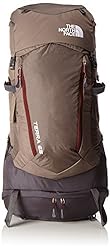 The North Face Terra has a molded hip belt, a side entrance zipper, a floating lid, and a comfortable and flexible back panel, making it among the best hiking packs. Due to its user-friendly layout and enough organizational storage, this elegant trekking buddy will easily find its home in your closet alongside other camping staples.
The North Face Terra has a molded hip belt, a side entrance zipper, a floating lid, and a comfortable and flexible back panel, making it among the best hiking packs. Due to its user-friendly layout and enough organizational storage, this elegant trekking buddy will easily find its home in your closet alongside other camping staples.
The cushioned shoulder straps and OPTFIT suspension system ensure a tight and secure fit. This hip belt is made from a breathable, comfortable air-mesh fabric and has plenty of pockets for quick access to your belongings. This is crucial for lengthy walks, since no one likes to feel their hips dig into the ground for too long.
The large, zipped side entrance and the bottom pockets for your sleeping bag provide easy access to all of your belongings.
What we like
- The small backpack can hold a lot without seeming big.
- Vertical channel increases back ventilation.
- Many pockets provide enough storage.
What we don't like
- Not commonly available online.
16. Lowe Alpine AirZone
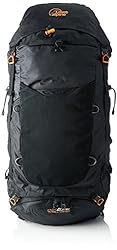 When hiking in warmer areas, the Lowe Alpine AirZone Trek+ backpack is an excellent choice due to its tensioned mesh system and huge open space between your back and the backpack, both of which provide excellent ventilation.
When hiking in warmer areas, the Lowe Alpine AirZone Trek+ backpack is an excellent choice due to its tensioned mesh system and huge open space between your back and the backpack, both of which provide excellent ventilation.
A sternum strap with whistles, a chest strap that can be adjusted, and a roomy hip belt with a harness work together to hold the weight close to your back and allow the harness to move with you as you go. You can fit your raincoat, food, and electronics into the two exterior pockets, the one that stretches, and the one that zips inside the pant.
The backpack’s cover can be expanded by ten liters, giving you additional space if you really need it. Don’t you think that’s remarkable? As an added bonus, this mini-ripstop Nylon and Polyester piece of gear comes with a phone harness and a rain cover to keep you dry and comfortable no matter what the weather throws at you on the trail.
What we like
- The backpack's rain cover is useful.
- Internal zipped pocket protects costly equipment.
- Cheap.
What we don't like
- The backpack is simple.
17. Osprey Levity 60 Ultralight
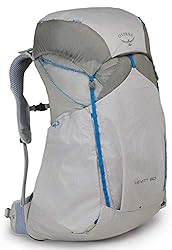 If you’re going on a week-long hike, you might not need a backpack that’s twice as tall as you are. What you need is a lightweight backpack like the Osprey Levity. Light as air, it’s constructed of ultra-high-molecular ripstop and Cordura Nylon.
If you’re going on a week-long hike, you might not need a backpack that’s twice as tall as you are. What you need is a lightweight backpack like the Osprey Levity. Light as air, it’s constructed of ultra-high-molecular ripstop and Cordura Nylon.
The 3.5mm Lightwire frame ensures that the weight is distributed evenly over your back, so you won’t become fatigued after only a few hours of trudging uphill. The cushioned ExoForm harness and the layered, seamless mesh give the maximum comfort and convenience for enduring challenging hiking paths.
Because of the 3D mesh back panel’s ability to promote airflow, you won’t have to worry about sweaty drips sliding down your back. You may quickly grab some munchies, your flashlight, and a knife from the top zipped compartment. If you’re already having a great time, the assurance from the All-Mighty Osprey will just make it that much better.
What we like
- Main compartment and side pocket compression straps secure the cargo.
- The backpack's cord-loop attachment points allow for extra packing.
- Dual-access side pockets hold food and water bottles.
What we don't like
- 30 pounds max
18. Berghaus Ridgeway 65+10L
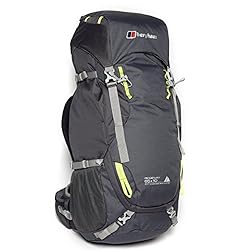 Do you appreciate having a variety of pockets and compartments to store your things in? If so, then the Berghaus Ridgeway 65+10L is the perfect hiking backpack for you. It’s robust Polyester construction allows you to load up on trail maps, snacks, and everything else you might need.
Do you appreciate having a variety of pockets and compartments to store your things in? If so, then the Berghaus Ridgeway 65+10L is the perfect hiking backpack for you. It’s robust Polyester construction allows you to load up on trail maps, snacks, and everything else you might need.
In addition, the side pockets may be expanded to provide an additional 10 liters of storage space for items like a tent, sleeping bag, or additional electronics. The hiking pack not only features zippers everywhere, but also a BioFit system that allows for the greatest possible comfort regardless of your size or shape when wearing it.
The harnesses may be adjusted in height and chest width, and there is a hip-belt with extra storage space. The hydration system is included in the backpack so you’ll never get to the point when you’re thirsty and ready to call it a day on the hike. If rain is in the forecast, you may use the included rain cover.
What we like
- The backpack contains room for essentials and non-essentials.
- The rain cover is included with the backpack.
- Side pockets add 10 liters to your backpack's capacity.
What we don't like
- Lacks originality.
19. Kelty Coyote 65
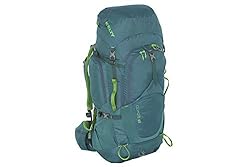 The Kelty Coyote 65 hiking backpack is the perfect accessory if you want to go on a hike in wet weather or cross rivers. The 65-pound capacity of this feature-rich transporter makes it ideal for weekend backcountry excursions with friends and family. Including a sleeping bag, several changes of clothing, and other minor goods, this is quite a lot.
The Kelty Coyote 65 hiking backpack is the perfect accessory if you want to go on a hike in wet weather or cross rivers. The 65-pound capacity of this feature-rich transporter makes it ideal for weekend backcountry excursions with friends and family. Including a sleeping bag, several changes of clothing, and other minor goods, this is quite a lot.
With the PerfectFit suspension straps, you can customize your backpack’s fit to your body, which is a major plus. In addition to its durable shoulder straps and roomy hip-belt, the LightBeam aluminum stays give this backpack an impressive lifespan.
There are zippered side pockets for quick access, and you may open the pockets without taking the bag apart. While your main bag is available for you at the campground, you may use the lid as a sling pack for daytime excursions.
What we like
- AMP-vented Flow's back panel reduces perspiration and keeps you cool.
- Fit-Pro torso adjustment and load-lifter straps support the load.
- Affordable.
What we don't like
- Compared to other hiking backpacks, the construction is weak.
20. Sierra Designs Flex Capacitor
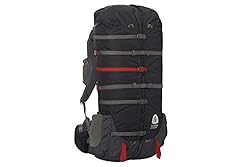 The Sierra Designs Flex Capacitor is an all-inclusive backpacking package. The pack’s patent-pending gusset system lets you to quickly extend it from 40 to 60 liters in size with only a few simple adjustments. Instead of expanding vertically like most backpacks do, this one widens at the sides so you can get to your belongings quickly and easily. It also means that you can gain or lose items at will.
The Sierra Designs Flex Capacitor is an all-inclusive backpacking package. The pack’s patent-pending gusset system lets you to quickly extend it from 40 to 60 liters in size with only a few simple adjustments. Instead of expanding vertically like most backpacks do, this one widens at the sides so you can get to your belongings quickly and easily. It also means that you can gain or lose items at will.
You can easily access your belongings on the go thanks to the side zippers and expandable side pockets. Load them up with necessities like food, drink, and sunglasses for a day hike. The hip-belt and shoulder straps of this backpack were both designed with your comfort in mind by using EVA foam.
When carrying heavy loads for extended periods of time, the compression straps, belt stabilizer, and load lifter straps on your backpack are invaluable. The journey as a whole is designed to assist you maintain balance and distribute weight evenly.
What we like
- The pending gusset method is useful when packing changes.
- The sturdy Y-shaped DAC Pressfit suspension is composed of aluminum.
- Cheaper than similar-sized hiking packs.
What we don't like
- Backpack fabric can jam zippers.

Why Choose a Hiking Backpack Over a Regular Pack?
Like I stated before, you don’t need to go out and get a special backpack only for hiking. This, however, does offer a few difficulties and some lost chances that might impact your trekking experience.
It’s possible that a conventional pack might get damaged while trekking due to the tough terrain and surroundings you can face. When you invest in a bag built for extreme weather, you may significantly reduce the extent of this damage. You won’t find most of the materials that go into making a hiking backpack in a typical pack, but they’re essential to the durability and longevity of a hiking backpack.
The design and features are another major distinction between the two. Many of the features that make best hiking packs so convenient, including water bottle sleeves, gear hooks, cushioned back panels, and an assortment of compartments, are not found on ordinary bags.
Hiking backpacks have superior suspension systems over everyday backpacks. This implies that you’ll be in a lot of discomfort with a regular bag because it won’t be able to contain all of your goods. Without a hiking backpack’s cushioned straps, hip belt, and robust frame, you’d have to bear the weight with greater effort.
It’s true that you can get by with just an ordinary bag for short excursions that don’t require much kit, but the best hiking packs are worth the cost. Does a standard backpack stack up after reading those hiking backpack reviews?
Best Hiking Packs Buying Advice
Capacity
Size restrictions on packs are seldom strictly enforced. There are several variables to consider, such as the duration of the trip and the time of year. There is one notable aspect. Pack only what you need, and don’t overburden yourself. Do you rely on outdated, inflexible equipment, or do you prefer to bring along backups? Then buy a bunch at once. Dimensions can be expanded with the help of a modern, lightweight tent and a down sleeping bag.
Most hikers use a pack that is 50–70 liters in capacity for trips that last between one and three days. Keep your load as light as possible and choose gear that compresses with a pack such as the Osprey Atmos AG 50/Aura AG 50. Those with a capacity of 60 liters or more are allowed to carry a few more goods, which is very helpful for families. Use these basic rules to govern your behavior throughout each spectrum, from modest to extensive.
Weight and Load Range
It’s also vital to estimate the whole weight of your gear, not just its volume. If your gear is outdated or you like a heavier setup, select a pack that can manage the extra weight. If you want simplicity and lighter gear, get a lightweight pack. Frame, suspension, and padding affect a backpack’s hauling ability. Nearly every model’s empty weight is listed.
A heavier pack can usually carry more. It features a sturdy frame, durable textiles, and cushioning. Some backpacks are getting lighter, yet they can still carry a large weight. Here’s how to match pack weight with hauling capabilities. Some manufacturers give load ratings for their packs.
Ultralight Backpacking Packs
Ultralight backpacks are becoming increasingly popular, and for a valid reason. These packs remove 2 to 3 pounds off the size of a normal camping pack and provide bare-bones organization. Thin, quality materials and minimalist suspension systems help them lose weight. If you want to lessen your burden and don’t mind a basic design, consider an ultralight backpack.
Ultralight packs are great, but you can’t overburden them. UL packs can’t manage weights exceeding 30 to 40 pounds due to their slim suspensions and thin materials. If you’re a thru-hiker or minimalist with a base load of 15 pounds or less, this shouldn’t be an issue. If you’re simply switching to lightweight gear, change your pack last. First get a lightweight tent, sleeping bag, pad, and cooking gear, then a UL pack.
Most ultralight packs are created by lesser-known manufacturers including Gossamer Gear, Hyperlite Mountain Gear, ULA, and Zpacks. This cottage business was established by thru-hikers unhappy with typical backpacking manufacturers’ hefty gear. It’s becoming popular with thru-hikers and casual hikers. All of these businesses satisfied us with their build quality, customisation, and customer service. The main disadvantages were wait times (many packs are created to order) and higher prices.
Padding and Support
Padding in the backpanel, shoulder straps, and hip belts is vital when choosing a pack. A correctly fitted up pack will lay most of the weight on your hips and keep the pack close to your back. Foam and cloth contribute weight, so producers balance weight and comfort. Foam cushioning adds comfort to non-ultralight overnight, weekend, and longer travel packs. We favor hard foam over soft, compressible foam. Extremely soft cushioning may feel fantastic at first, but it doesn’t provide the long-term support needed for higher weights. Gregory Baltoro/Deva and Osprey Aether/Ariel employ high-quality, solid padding effectively.
Very lightweight gear sometimes lacks padding in the hipbelt and/or shoulder straps, thus keeping your loaded weight low is essential. Some lightweight packs, like the Osprey Exos 58/Eja 58, balance weight and support with a mesh construction and thin foam. We don’t advocate bringing more than 30 pounds with an ultralight pack; 25 is best.
Ventilation
Back panel and hip belt airflow is important if you run hot or want to hike in the summer. Finding an internal-framed pack that breathes effectively might be difficult because a pack should hug and contour to your body while you walk. Most packs feature foam and mesh sections that encourage ventilation, but you’ll still get sweat art where the foam panels touch your body. Osprey’s Anti-Gravity (on the Atmos/Aura) and Gregory’s FreeFloat (on the Focal/Facet) include a completely suspension mesh backpanel and hipbelt that cushion the body while permitting breathability. This design is great for individuals who like ventilation, but it reduces the main compartment’s capacity and won’t handle big items.
Water Protection
We put a camera, phone, and down back pack in our backpacks, so we prioritize water protection. Most backpacks offer reasonable water protection with hard-face nylon and a DWR coating, but heavy rain will penetrate. Dyneema-made waterproof backpacks are also available. The 100% Dyneema Hyperlite Windrider worked well as a dry bag.
Unless you have a waterproof backpack, take extra steps to keep your things dry. The Gregory Baltoro/Deva and Gregory Paragon/Maven have built-in waterproof covers.
Backpack Sizing and Fit
Sizing and fitting your pack appropriately is crucial to trail pleasure. Men’s and women’s packs available in 1-3 sizes. These sizes differ primarily in torso and hip dimensions and torso length. The Osprey Atmos comes in small/medium and large/extra-large sizes; the former fits 17 to 20.5-inch torsos. If your hips aren’t proportionate to your body, use a pack with an adjustable hipbelt. Gregory Baltoro/Deva and many lightweight packs include changeable hipbelts.
Final Thoughts Best Hiking Packs
It’s important to take into account your own requirements while shopping for the best hiking packs. It takes time to research the best hiking packs, but I’ve done that for you here.
Pick your preferred lightweight pack and leave the heavy stuff at home for day walks with the feature-rich backpacks designed for multi-day treks. All of these concerns and more are addressed in the aforementioned evaluations, with additional attention paid to key concepts from the buyer’s guide.
Select a backpack, put it through its paces for a while, and then come back here to share your thoughts on how it performed.
You may read our review Best Cheapest Roof Top Tents of 2022
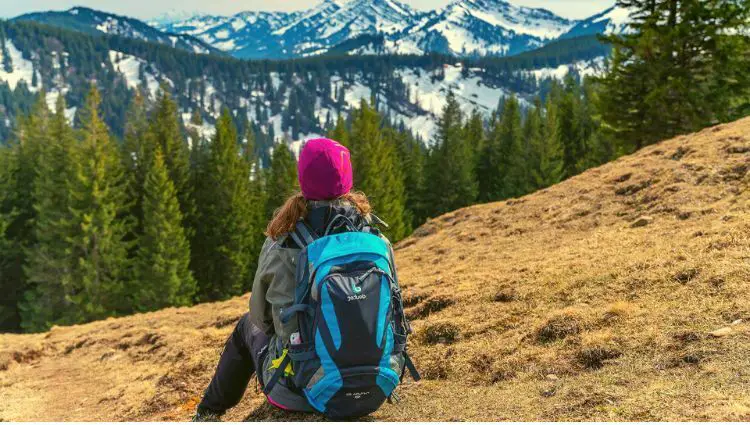
Best Hiking Packs- FAQs
Q. Can rain get inside a hiking pack?
Many best hiking packs have membranes that can withstand some moisture, but this does not make them waterproof. However, the Nylon or Polyester utilized in their construction will keep water from collecting in your bag. When you go trekking, they assist you maintain a constant load by preventing water from seeping through your gear.
- Protection from the Rain
There are a few things you can do to ensure that your hiking backpack will remain dry and safe even in the worst storms. Consider covering your backpack with a waterproof tarp. You may usually find one crammed into the bottom compartment of your bag. The thin fabric of a rain cover makes it difficult to gain access to your belongings and increases the risk of the cover being hooked on nearby plants and tearing.
- Lining
It’s also a good idea to use a plastic bag or another well-fitting liner to protect the interior of your hiking backpack from the elements. In the event that your bag becomes wet, having a heavy-duty liner will better ensure that your belongings remain dry. However, you should pick a plastic bag or liner that is bigger than your backpack. To better tuck the bag’s corners and seal it, start with additional fabric.
- Closure Bags
Zip-top bags and dry sacks are another option. If you have a lot of belongings that need to be safeguarded against water, you will need quite a number of them. You might as well make the most of zip locks if you’re going to be packing electronics that need to be kept dry.
Q. Is a 50L hiking backpack enough?
A 50-liter backpack is plenty for a day trek on the weekend in moderate weather. You may pack a tent, sleeping bag, water filter, several changes of clothes, and cooking gear like a stove, pot, and food bag, all of which will contribute to a comfortable and enjoyable hiking journey. If you’re a minimalist and don’t require a lot of items to keep you safe and pleased, you can even embark on a multi-day hiking journey.
However, a 60L hiking pack is a better choice if you want to bring a tent, a cushion, and a few other commodities that will ensure a stress-free journey. It’s an upgrade from the last choice and has enough capacity for a king-sized sleeping bag and other space-hogging necessities.
Q. How should a hiker prepare their bag for flight travel?
Packing for a hiking vacation in a foreign location that involves flying takes careful consideration of both convenience and comfort. Do not put your hiking bag in the plane’s hold if you can help it. To do this, you should just bring the essentials and leave behind the extra baggage you’ll just have to buy once you get there. Since hiking gear is notoriously cumbersome and takes up the most room in a suitcase, you could alternatively just wear it on the aircraft.
Packing in the right sequence is essential for your convenience and making full use of the space in your bag. When packing a backpack, it’s best to start with the lighter, less important items so that the load is well distributed. The contents of your hiking backpack’s base should include a sleeping bag, an additional set of footwear, and a headlamp.
Place sensitive electronic equipment in the middle, where it will be safe from both sides. Even while this prevents your electronics from being broken, it is still a great idea to store them in the box or bag they came in to avoid any dings or scratches. Last but not least, keep your flight necessities in an easily accessible location at the top of your backpack. An electronic reading device like a Kindle, a thin coat, an eye mask, a hygiene bag, some snacks, and your documents are the very minimum.
In addition, be sure that your hiking bag complies with TSA regulations and contains no items that might be confiscated. There is no enjoyment in doing this, and the potential danger is too great.
Q. Is there a difference between a backpack and a rucksack?
Simply said, a backpack is a bag designed to be carried on the back. Whether it is a hiking, traveling, or everyday backpack, it features two shoulder straps and is constructed of waxed/crafted canvas or leather. The hip belt of a backpack bears the bulk of the load, not the shoulder straps.
- Backpack
A great backpack will include a hip belt that allows you to shift the weight of the pack from your shoulders to your hips, where the weight is supported by the largest muscle group in your body — your legs. If you want to carry large weights without experiencing back pain, make sure your backpack’s hip belt is long enough to go over your hips rather than just around your waist.
- Rucksack
Simply put, a rucksack is a specific kind of bag designed for usage in the great outdoors, particularly while camping or hiking. There are plenty of compartments and straps to secure the pack to your body and keep your belongings safe. Rucksacks often come with both hip and chest straps to evenly distribute your load. A durable rucksack is the best choice for extended outdoor excursions and international vacations.
- Rucksack Vs Backpack
The only real distinction is that rucksacks often have a top that may be tightened or fastened. The ease with which they may be grabbed makes them a good fit for usage by military personnel. A backpack and a rucksack both serve the same purpose in that they allow you to carry a big weight without tiring as rapidly as you would without th


